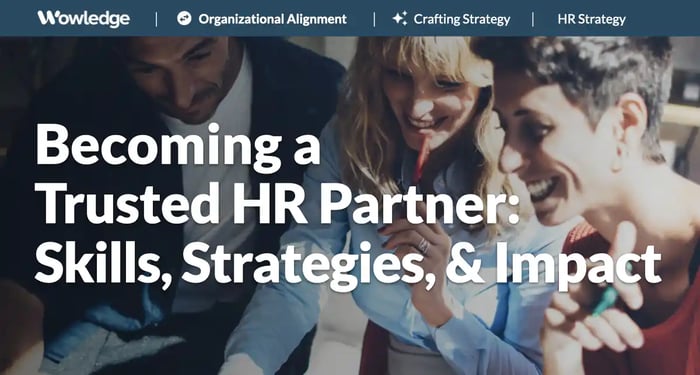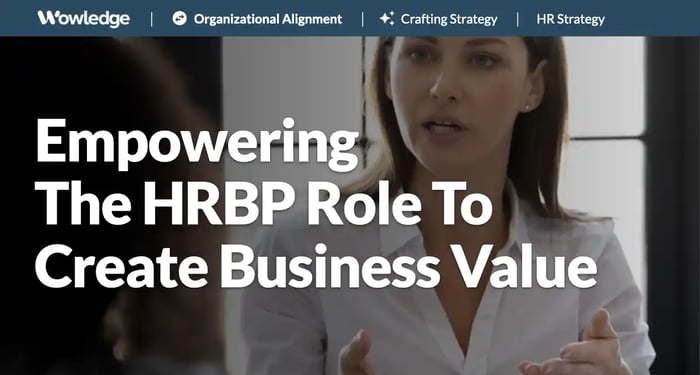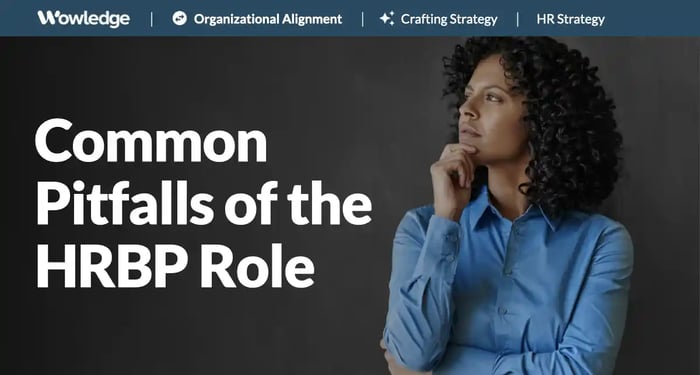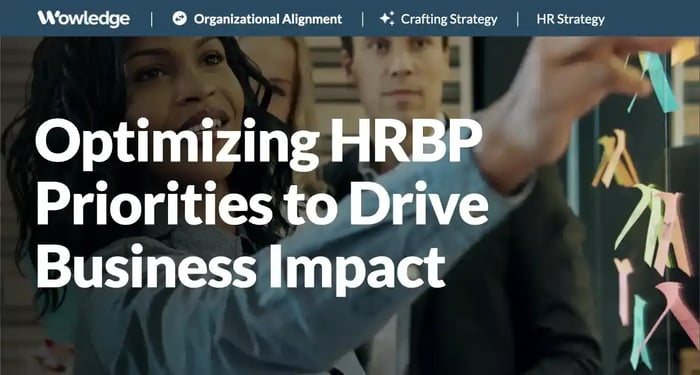Table of Contents
- The skills and behaviors that lead to a trusted HR partner status
- Practicing advanced consulting skills and methods
- 1. Identify future strategic directions and supportive and limiting trends
- 2. Focus on solving business issues
- 3. Build a business case
- 4. Create a reliance and culture of root cause identification
- 5. Engage business leaders in problem identification and resolution
- 6. Measure to demonstrate objective impact
- 7. Follow a structured and repeatable process
- 8. Leverage change management approaches
- 9. Exhibit and promote a bias for action and results
- Relevant Practices & Tools
- About Wowledge
The focus and goals of HR leaders and their teams have, for years, centered on being a trusted business partner that contributes to the overall health and vitality of the businesses they support. Emanating from Dave Ulrich’s 1997 classic, “Human Resource Champions,” the term “strategic partner” was identified as one of four crucial roles that HR should fulfill (the others being administrative expert, employee champion, and change agent). While the thinking, concepts, and principles of robust and impactful HR have evolved considerably since that time, the concept of becoming and sustaining a trusted HR partner status has remained a foundational element.
Establishing a reputation as a trusted HR partner is a continuous challenge, as leading teams of HR professionals who provide consistent services while exhibiting the ideal set of behaviors represents an enormous challenge. It can be challenging as organizations face potentially disruptive changes, such as new competitive challenges, replacing leaders more frequently, and responding to market and economic fluctuations. Maintaining a trusted HR partner status is especially challenging in multi-unit and multi-function organizations, where HR professionals and teams may be geographically dispersed, reporting to different business leaders with varying priorities and agendas, and perhaps most challenging to manage, widely differing leadership and work styles.
Developing such a status requires establishing a sturdy and reliable relationship with business and operational leaders, reinforced on a continuous basis by understanding and responding to their needs to meet and exceed financial, operational, stakeholder, and market objectives. It requires the use of approaches that demonstrate a commitment to methods they understand and resonate with, and aligning fact and reality with the all-too-human opinions, biases, and preferences they face as leaders of people. A trusted HR partner can speak their language, focus on their key concerns, and operate in ways that are not entirely foreign to them, all while helping them navigate the people-related and -reliant nuances of getting the organization’s work done successfully. Those require trusted relationships.
The skills and behaviors that lead to a trusted HR partner status
"Trust" is defined by Merriam-Webster as “a firm belief in the reliability, honesty, and ability of someone or something, forming the foundation for relationships and cooperation”. Establishing trusted HR partner relationships is essential to their strategic success and requires an appreciation of the psychology of how trust is developed and maintained over time. Exhibiting these qualities creates and sustains the kind of relationships that HR and business leaders hope for—those characterized by solid and credible counsel, solutions that deliver the necessary results, and a shared sense of accomplishment over the achievement of jointly owned goals and objectives.
These create a foundation for further action that focuses on supporting the success of leaders and their organizations.
Building trusting relationships
Psychological research has found that a particular set of behaviors establishes trusting relationships between individuals and groups of people. The primary characteristics of creating trust are certain “truths:” it is earned, and built on shared vulnerability, authenticity, and established and maintained over time. Studies have identified four key elements that can be used to guide HR professionals as they work with their internal stakeholders:
- Competence: demonstrating expertise and knowledge, acting in accordance with agreed-upon plans, and creating solutions that achieve or support the success of others.
- Consistency: meeting commitments, expectations, and acting and treating others in a reliable and dependable manner.
- Integrity: acting and communicating with honesty and transparency, admitting mistakes, and being accountable.
- Compassion: demonstrating empathy by voicing and validating others’ perspectives, not judging based on one’s own beliefs, accepting others’ influence, and showing support despite setbacks or failures.
Other insights into building trusted HR partner relationships include:
- Maintaining open and frequent communications
- Establishing and respecting boundaries
- Giving without expectations of receiving
- Being other-centered
Sharing a deep-rooted focus on the business
Trusted HR partners operate in a way that creates strong common bonds with business leaders on business priorities and objectives. They invest a significant amount of time and effort in learning and developing their expertise on how the business operates and generates value for its stakeholders. Their actions and behaviors signal a shared passion and focus for continuously identifying ways to improve operational, financial, and output quality outcomes for the company, its customers, and its stakeholders. They demonstrate this commitment by:
- Participating in business strategy development sessions.
- Attending business and operations reviews.
- Spending time with peers and their teams in Finance, Operations, Marketing, Purchasing, Sales, and others.
- Understanding the relationship the business has with its customers and the relevant marketplaces, communities, and regulators.
- Researching and keeping up to date on its competitors and competitive positioning, advantages, and potential.
- Creating opportunities for regular conversations on the status of operational, financial, and customer outcomes.
Building collaborative relationships
Managing a trusting relationship requires a continuous effort to establish and maintain it through regular interactions that are targeted towards providing support, counsel, and feedback. Solid and lasting relationships are based upon two-way exchanges as equals, with each party accepting and providing support from the other. In this way, trust is created as the HR leader acts in a way that avoids a one-way advisory association (e.g., as a service provider of lesser status), and instead acknowledges the value and expertise of the business leader as a partner and colleague. Such a collaborative relationship is built and sustained through:
- Being proactive by setting meetings, coming prepared with an agenda and topics, no matter how brief.
- Meet regularly to maintain personalized contact and become aware of emerging business challenges early on.
- Maintain contact equally with peers who are influential, supportive, as well as those who may be critical of HR’s role and efforts.
- Invite peers and influential others as collaborators in HR strategy, planning, and prioritization sessions.
- Provide useful insights, information, and coaching that can help guide leaders’ actions and directions.
- Request feedback and ideas through regular check-ins to solicit pain points, respond with solutions, and execute fixes.
Practicing active listening
Great listeners are often regarded as effective conversationalists because they give their discussion partners time to explain their concerns or perspectives, ask probing follow-up questions to understand their thinking, indicate understanding through feedback, and then provide their perspective and reaction. A core element of being a trusted partner lies in communicating that understanding the other person’s perspective is of vital interest and importance. When used with the proper motivation, it makes the other party feel “heard”, validated, and valued. This is also a method for role-modeling how the leaders can more effectively consider others’ viewpoints before countering or dismissing them.
Coaching and advising
Building on active listening, the use of coaching skills and approaches focuses distinctly on the leader being coached, as opposed to the expertise and ideas of the trusted HR partner. In this leader-centric manner, the trusted HR partner asks “powerful questions” that help guide the leader to generate their own understanding of the problem and develop action plans. It is designed to empower them by generating their own clarity on issues, options for action, and facilitating behavioral change. It focuses on helping free them from limited views and discover new perspectives, pathways to solutions, and action plans that drive their desired outcomes. Trusted HR partners understand the difference between coaching, advice, and consultation, and choose between them to develop solutions while enlarging the problem-solving perspectives and skillsets of their leaders.

Practicing advanced consulting skills and methods
Making meaningful contributions to business and operational outcomes builds on the trust generated through personalized, frequent, and authentic contact. A trusted HR partner leverages their expertise to communicate forthcoming trends, create solutions focused on critical financial or operational outcomes, and execute them using methods that inspire trust and heighten the credibility of HR as a business professional. The following actions build on and reinforce the trusted HR partner relationship established through the consistent application of the fundamental interaction and communication skills referenced above.
1. Identify future strategic directions and supportive and limiting trends
Developing an understanding of where the organization is heading is the starting point for comparing it against notable internal (key employee turnover, decreasing engagement, and creeping skill gaps) and external (labor market, economic, competitive, and consumer) trends. Such an ongoing assessment enables the projection of impacts and challenges to strategy and goal achievements that the organization will face in the months and years ahead. Being able to identify those issues well in advance of their potential to negatively impact operational success provides valuable insights for managers who can become advocates and partners for HR initiatives designed to overcome or avoid them.
2. Focus on solving business issues
The trusted HR partner prioritizes people-related opportunities that directly or indirectly impact business, financial, or operational outcomes. This goes beyond creating initiatives to improve talent outcomes alone and requires an assessment of business strategies and operational initiatives to identify opportunities where HR can make meaningful and impactful contributions. To accomplish this, draw a distinct line between talent processes and proposed fixes, aligning them with business objectives using proven or at least well-hypothesized relationships (e.g., engagement levels as drivers of increased performance or productivity) that can be tested. Even more robust is the use of analytics to identify the extent to which HR processes and functions (total rewards, recruiting, performance management) correlate to, or predict operational or business outcomes. Similarly, the trusted HR partner designs interventions that are demonstrated and specifically tailored to impact enhanced revenue, income, expenses, and market share.
3. Build a business case
Trusted HR partners should adopt the requirement that all HR initiatives—large or small—start with a proposal and business case for approvals that outlines the problem, defines solution options, and states the intended business benefit. Through this, a formal and disciplined discussion can be used to help business leaders understand how and why a particular solution path is being proposed, as well as the risks and costs versus the benefits of the approach. This is a good example of using language and approaches that will resonate with business leaders and preemptively address anticipated questions. A business case template should be created for standardization, including a problem statement, proof of concept or basis for solution options (data, research, or best practices), project approach and methods, risk and cost-benefit analysis, cultural implications, and a description of how outcomes will be measured.
4. Create a reliance and culture of root cause identification
Knowing the true reasons for issues and barriers to success that have arisen is an essential step towards building credibility and trust in HR’s proposed efforts and initiatives. Trusted HR partners resist the urge or pressure to accept what is presented as the “most obvious” or surface explanations for a) what is happening, b) why it is happening, and c) the extent to which it is happening. Even when conducted as a brainstorming (as opposed to data- and analytically derived) activity, objectively based assessments of root causes are more likely to resolve the presenting problem. At the end of the day, while business leaders might prefer a “quick and dirty” solution based upon instinct and experience, HR leaders can demonstrate the power and value of this over time.
5. Engage business leaders in problem identification and resolution
Creating efficient and rapid co-created solution opportunities and actions strengthens a trusted partnership between HR and line leaders (and their teams) as they enhance business alignment. By engaging them directly in problem-solving, leadership buy-in and approvals are gained, which allows their team members to build skills while developing new solutions to the issues that slow their progress towards meeting goals. It also has the value of bringing root cause identification and solutioning to those closest to the problem. This helps address the question of “what’s in it for me (WIIFM),” which improves ultimate solution acceptance and adoption while building trust in HR as a partner that can help improve business objectives.
6. Measure to demonstrate objective impact
Building trust requires demonstrating competence, which can be established and maintained by relying on accepted data-centric and analytically sound practices. Using objective means to detect issues or trends, assess situations and circumstances, define causes, and identify potential solutions and likely opportunities for business impact brings confidence to HR guidance. Where many business leaders believe that measuring human behavior, preferences, beliefs, and actions is “too hard”, bringing objectivity to understanding people-based occurrences, trends, and concerns about these issues can only add to the credibility of HR capabilities.
7. Follow a structured and repeatable process
A trusted HR partner relies on disciplined and rigorous processes to address organizational challenges, thereby building confidence in its business-like approaches and practices. Start with an overarching mentality that guides HR practitioners, such as evidence-based HR (EBHR), as the basis for identifying trends, root causes, potential solutions, and outcome evaluation. EBHR calls for the use of scientific evidence, integrated talent and business data, expert insights, and stakeholder perspectives.
From a credibility standpoint, business leaders recognize the value of formalized methodologies, such as those employed in process improvement (e.g., Lean, Kaizen, Six Sigma), to identify the most suitable process refinements for optimizing workflow and customer outcomes. Similarly, HR leaders and teams should rely on those, as well as well-established approaches such as organization development (OD), performance consulting, and design thinking methodologies. Each of those has commonalities that bring tremendous value to HR and its contributions to business objectives:
- Structured project approach with team formation, specified purpose, objectives, activities, and timelines.
- Client involvement and HR facilitation.
- Reliance on objectivity using data and analyses on business and talent KPIs, surveys, focus groups, and interviews.
- End-user feedback and shared alignment on actions.
- Outcome measurement for assessing the impact of changes.
One key to successful implementation is selecting the appropriate approach based upon the nature and potential root causes of the issue (process, practice, people, and/or platform). The other is the need for the project team and the sponsoring business leader to maintain an openness to the core issues and their root causes, such as process design, worker responsibilities and accountabilities, job design, team dysfunction, and technology configuration.
8. Leverage change management approaches
Many initiatives and efforts guided by trusted HR partners require that stakeholders understand their rationale, objectives, and value to them and their organizations. Given that improvements involve changing how work is conducted, by whom, against new standards, and using certain tools, the need to manage stakeholders' acceptance, adoption, and application of those changes is the crucial and final element of implementation. Strategic change management is a best practice that engages end-users, their leaders, and the design and implementation teams in an awareness and skill-building process, helping ensure that the changes take hold as designed.
9. Exhibit and promote a bias for action and results
Becoming a trusted HR partner requires an appreciation of the old adage that “actions speak louder than words”, and Benjamin Franklin’s “a well-done is better than a well-said”. Too often, well-considered plans are delayed or sit idle, creating frustration for those whose benefit they were developed. A focus on execution and achieving improvements generates confidence among line leaders that HR teams deliver on their promises. Consider plans that include small, early victories to build momentum and trust in HR approaches, with project plans identifying milestones that can be promoted as signs of success. Avoid creating heavy and bureaucratic project or solution structures that can lessen interest and lengthen deployment timeframes. Recognize and reward HR team members who adopt these action-oriented practices as their standard operating procedures to change the culture in HR and expectations from line leaders.
Relevant Practices & Tools
Core HR Strategy Practices to Define a Foundational Direction for the HR Function. >
An HR Strategy sets business-based human resource (HR) tactics that will constitute a comprehensive multi-year approach to managing the HR function's structure, governance, programs, policies, and practices... more »
Applying Organization Development Principles to Uncover Opportunities for Improving Organizational Performance and Health. >
Organizations are constantly in flux, with multiple change efforts underway. HR is being called upon to facilitate more and more of these endeavors, using Organizational Development tools, methodologies, and frameworks... more »
Conducting Performance Consulting-based Learning Needs Assessments for Specialized Solutions. >
“Performance Consulting” addresses workplace performance issues through a structured approach to understanding and resolving them... more »
Building a Culture of Coaching and Mentoring that Creates a Continuous Learning and Improvement Environment. >
Establishing and managing a sustainable culture of coaching and mentoring is an integrated effort that builds an environment where continuous development and growth take center stage... more »
The Change Readiness Approach Tool: Define, Measure, and Report Organizational Readiness to Adopt New Ways of Working. >
The purpose of the change readiness assessment is to understand the readiness for change across the various stakeholder groups, with a focus on identifying the opportunities and barriers that may impact adoption of the new ways of working... more »
About Wowledge
Wowledge is the implementation-first platform designed for lean HR teams and consultants who need to design and scale strategic HR programs efficiently—without starting from scratch.
Our members gain access to continuously updated best practices, step-by-step guidance, expert-built tools, and customizable templates—all structured to accelerate the development and implementation of key HR programs.
Recognizing that every organization operates at different levels of sophistication, Wowledge’s scalable system of best practices follows a stage-based approach—Core, Advanced, and Emerging—ensuring HR professionals can implement solutions tailored to their organization’s unique needs and goals.
Your Shortcut to Amplifying HR Impact!
Get started for FREE! Learn more.










